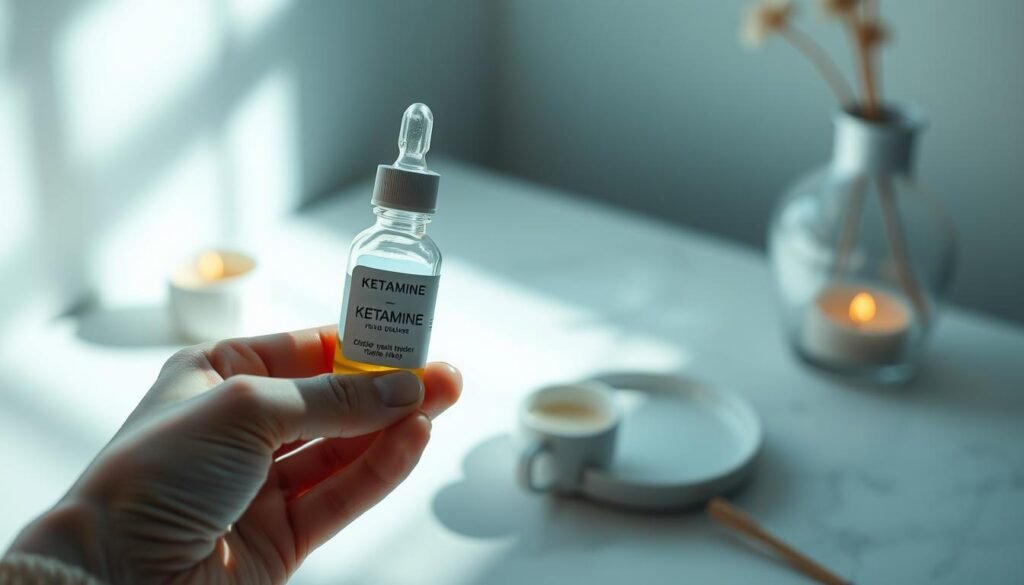Could a substance mainly used for anesthesia be a breakthrough for depression? Ketamine is getting attention as an alternative treatment for hard-to-treat depression. People are learning about ketamine’s benefits and how it can quickly relieve symptoms. This guide explores how ketamine works, how to take it, and why taking it under the tongue could help many overcome depression.
Key Takeaways
- Ketamine is a promising treatment for treatment-resistant depression, affecting 30% of patients globally.
- Recent studies suggest that 6 doses of sublingual ketamine may yield better outcomes than 3 doses.
- A significant number of patients reported notable improvements in anxiety and depression symptoms following ketamine treatment.
- Patients have experienced rapid relief and improved quality of life thanks to sublingual administration methods.
- There is increasing interest in ketamine treatment for those with co-occurring anxiety disorders.
- Research indicates that sublingual ketamine has a higher bioavailability than oral forms, enhancing its efficacy.
- Patients should consider potential side effects and consult qualified providers for the best treatment options.
Introduction to Ketamine as a Treatment for Depression
Ketamine has become known as a new way to treat depression. It’s especially useful for people who don’t find help from usual treatments. Its fast-acting nature sets it apart from other medicines that take longer to work. Doctors have seen a single dose of ketamine can quickly improve mood in those with major depression or bipolar disorder.
One ketamine treatment can make a difference for about a week. This can be very helpful for those in a severe low. In 2019, the FDA approved esketamine for hard-to-treat depression, recognizing ketamine’s value.
Though ketamine has great effects, it’s mostly given under doctor’s watch because of side effects. These effects, like feeling disconnected or raised blood pressure, are usually manageable when they happen. Now, taking ketamine in small doses at home is also becoming a possibility, making it easier to access.
Studies show ketamine might also help improve how the brain works in people with PTSD or anxiety after long-term use. Research from places like Yale supports the idea that ketamine can better brain function with repeated use. It might even help reduce cravings for those struggling with addiction.
Ketamine offers fast-acting relief for depression, making it an exciting field for mental health research.
Understanding Treatment-Resistant Depression
Treatment-resistant depression (TRD) is hard for those with major depressive disorder (MDD). It’s when usual treatments don’t work, leaving people to look for other solutions like depression alternative therapy. This issue affects roughly 30% of individuals diagnosed with MDD worldwide.
Definition and Prevalence
TRD happens when someone doesn’t get better after trying several standard medications. About 17% of people will deal with MDD in their lifetime. With 5% to 9% facing it in any given year. This makes it important to find new ways to help, like using treatment-resistant depression ketamine. Many studies show it can really help.
Challenges in Traditional Treatments
Finding the right treatment for depression can be tough. Only about 47% feel better with the first try of antidepressants like citalopram. But, 71% with TRD see improvement with ketamine treatments. This shows we need to think differently about treatment options.
Sticking with just the usual meds can lead to long periods of not feeling well. That’s why some turn to options like ketamine therapy for help. For deeper insights, take a look at this article. It goes into more on managing TRD today.
What is Ketamine?
Ketamine was first made in the 1960s for use in surgeries. It was soon found to help with mood, especially in those feeling very down. This discovery made it a key tool for fighting severe depression.
Historical Perspective on Ketamine Usage
In the beginning, ketamine was known for making people sleep during surgery. But in the early 2000s, its ability to lift depression was uncovered. It became a beacon of hope for those with hard-to-treat depression.
Mechanism of Action
Ketamine works differently than standard depression meds. It affects glutamate, a key brain chemical, improving mood quickly. People can feel better in just 6-12 hours, unlike the weeks needed for other meds.
Exploring Ketamine Sublingual Dose for Depression
Sublingual ketamine is gaining popularity for treating depression. This method is noted for being easy to use. People find it an appealing choice over other ways. Doses vary from 0.1 mg/kg to 0.75 mg/kg, depending on what each person needs.
Dosing Strategies for Sublingual Ketamine
Understanding each person’s needs is key to sublingual ketamine dosing. It usually starts at 300 mg. The dose may change based on how well it works and its safety. Many find doses between 300–450 mg/kg effective in fighting depression and anxiety.
Administration Methods
Sublingual ketamine is easy and safe to use. It comes in quickly dissolving tablets that go under the tongue. This method gets into the bloodstream fast. Unlike IV methods, it doesn’t need a hospital visit. So, patients can treat themselves at home, which helps them feel more in control.

Sublingual ketamine improves the treatment experience and outcomes. Its success makes it a notable choice for those looking into alternative depression treatments.
| Dosing Range (mg/kg) | Common Effects | Administration Method |
|---|---|---|
| 0.1 – 0.75 | Reduction in depressive and anxiety symptoms | Sublingual rapid dissolve tablets |
| 300 – 450 | Substantial symptom relief | Easier home administration |
The Advantages of Sublingual Ketamine
Sublingual ketamine offers benefits for those needing effective depression treatment. It’s unique because patients can use it at home. This makes it easier and more accessible than traditional therapy.
Convenience and Accessibility
With ketamine taken sublingually, it’s easier for patients. They can avoid frequent clinic visits. Avoiding intravenous infusions saves time and money. For instance, ketamine infusions cost between $400 and $800. Sublingual doses are about $50 each. Also, nearly 89% of patients see improvement in anxiety and depression after just four sessions. This ease of use improves adherence, making it popular among patients at a ketamine clinic for depression.
Cost-Effective Treatment Alternatives
Sublingual ketamine is a cost-effective choice for many. It has shown high success rates, with 70% of patients improving. This option reduces costs compared to intravenous therapy. Moreover, patients benefit from minimal dosing with sustained results. And with less than 5% experiencing side effects, it’s a reliable choice for those watching their budget and needing effective treatment.
| Aspect | Ketamine Infusions | Sublingual Ketamine |
|---|---|---|
| Average Cost per Treatment | $400 – $800 | $50 |
| Success Rate | 70% | 75% (based on VLDS) |
| Access Method | In-clinic only | At-home |
| Reported Side Effects | Varied | Less than 5% |
| Bioavailability | N/A | 30% |
Research and Efficacy of Sublingual Ketamine
Interest in sublingual ketamine for beating depression is growing. This is because of many positive studies. These studies show that this form can really help those with treatment-resistant depression.
A phase 2 study looked at an oral ketamine product, KET01. It was given in 120 mg or 240 mg doses each day. Those who took the 240 mg dose felt much better, especially on days 4 and 7, when compared to a placebo.
Clinical Studies Supporting Sublingual Ketamine
KET01 showed lasting improvements up to day 21, and the effects even stayed weeks after treatment stopped. This underlines how it can keep symptoms in check over time. Unlike traditional ketamine treatments, sublingual ketamine causes fewer dissociative side effects. This makes it easier to take for many.
Comparison with IV Ketamine and Esketamine Nasal Spray
When we look at sublingual ketamine, its effectiveness is similar to IV ketamine and esketamine nasal spray. Both of the latter treatments work fast but their costs greatly differ. Esketamine nasal spray is about $800 per dose, while ketamine injections are only about $5 each. This huge cost difference shows the financial advantage of choosing sublingual or injectable ketamine over nasal sprays.
Sublingual ketamine not only works well against depression but is also a cheaper, sustainable option for those struggling with TRD. Constant research and clinical studies are important. To learn more, you can check studies on clinical trials on the effectiveness of sublingual options.

| Type of Treatment | Cost per Dose | Administration Method | Onset of Action |
|---|---|---|---|
| Sublingual Ketamine | Variable (typically lower than nasal spray) | Tablet/Lozenge | 1 to 2 hours |
| IV Ketamine | $5 | Injection | 2 hours |
| Esketamine Nasal Spray | $800 | Nasal spray | Rapid (within hours) |
Potential Side Effects of Ketamine Treatment
If you’re thinking about ketamine treatment, it’s crucial to know the possible side effects. Ketamine can help with depression, especially when taken under the tongue. But, knowing the risks is important for everyone involved.
Common Adverse Effects
Ketamine can cause several common side effects. These include:
- Nausea
- Dizziness
- Headache
- Vomiting
- Pain or irritation at the injection site
Usually, these side effects don’t need medical help. But, some people might get serious reactions. Allergic reactions or heartbeat changes can happen. Ketamine off-label use can lead to unexpected side effects because it’s less regulated.
Long-term Risks and Considerations
Using ketamine for a long time may cause dependency. Studies are looking into how ketamine affects people over time. This is especially true for those with substance use issues. Ketamine can also interact badly with some antidepressants, like fluoxetine and sertraline.
Ketamine needs to be given in controlled settings. This helps manage its side effects and potential risks. Both ketamine and esketamine can treat hard-to-treat depression. But, doctors need to make careful risk assessments.
To learn more about ketamine’s side effects, check out the discussions here. Research is ongoing to understand ketamine’s long-term impacts better. This will help improve treatment guidelines and patient safety.
How to Find a Ketamine Clinic
Finding the right ketamine clinic is key for treating mental health issues. It’s crucial to choose a provider with the right knowledge and experience. They should understand treatment protocols and how to safely watch for side effects. You can find a good clinic by researching and getting advice from health professionals.
Choosing a Qualified Provider
Look for a clinic that puts patient safety and care first. Check the clinic’s credentials and the healthcare team’s qualifications. Good clinics offer medical advice, counseling, and support to make treatment better. Asking about their experience, treatment methods, and services can make you feel confident in your choice.
Questions to Ask During Consultation
At your first ketamine clinic visit, don’t hesitate to ask questions. Find out about treatment costs, including counseling. It’s crucial to talk about how they track side effects since ketamine can cause reactions like a faster heart rate and tiredness. Learning about their treatment plans and personalized care can show how well ketamine might work for you.